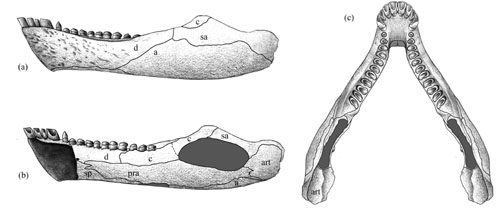
Diadectomorpha is a clade of Permo-Carboniferous tetrapods, which was previously only reported from North America and Germany. Although this clade is only moderately diverse, it is central to discussions of Late Palaeozoic vertebrate evolutionary history. It is the first and most diverse example of high-fibre herbivory and is critical to the origin of modern terrestrial communities. Diadectomorpha is also widely accepted as the sister taxon to crown-group Amniota, giving it significant influence on our understanding of amniote origins.
In the latest issue of Biology Letters, Dr. LIU Jun from Institute of Vertebrate Paleontology and Paleoanthropology (IVPP) of the Chinese Academy of Sciences, and Gabe S. Bever from New York Institute of Technology report first discovery of a new diadectomorph, Alveusdectes fenestralis, outside North America or Germany and the first evidence that Diadectomorpha survived the Lower Permian on the basis of one partial skull with lower jaws from the Upper Permian of the Shangshihezi Formation in Jiyuan, Henan, China. The generic name derived from the Latin alveus, meaning reservoir and referring to the type locality near Xiaolangdi Reservoir.
Alveusdectes fenestralis is distinguished as a diadectomorph in early tetrapods for heterodont dentition with anterior procumbent anterior teeth, transversely expanded, molariform cheek teeth and presence of parapet. A. fenestralis has large suborbital fenestrae, which is the source of the specific epithet.
Approximately 16 Myr younger than any other diadectomorph, Alveusdectes is the product of at least a 46 Myr ghost lineage. We can deduce that the diadectomorph was survived in Russia and central Asia before entering the relatively isolated continent of North China. The discovery of Alveusdectes raises important questions regarding diadectomorph extinction dynamics including what, if any, ecological factors limited the diversity of this group in eastern Pangea.
This study is mainly supported by 973 Program of China.

Fg.1 Alveusdectes fenestralis in dorsal (upper) and lateral (Lower) view (Image by LIU Jun)

Fig.2 Reconstruction of mandibles of Alveusdectes fenestratus (Image by LIU Jun)

86-10-68597521 (day)
86-10-68597289 (night)

86-10-68511095 (day)
86-10-68512458 (night)

cas_en@cas.cn

52 Sanlihe Rd., Xicheng District,
Beijing, China (100864)

